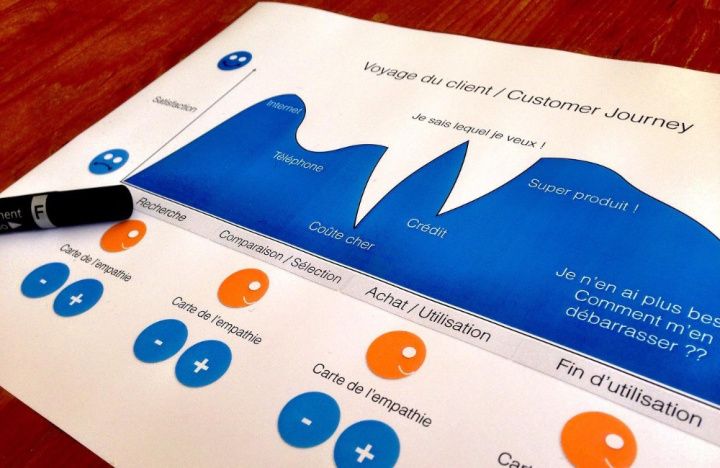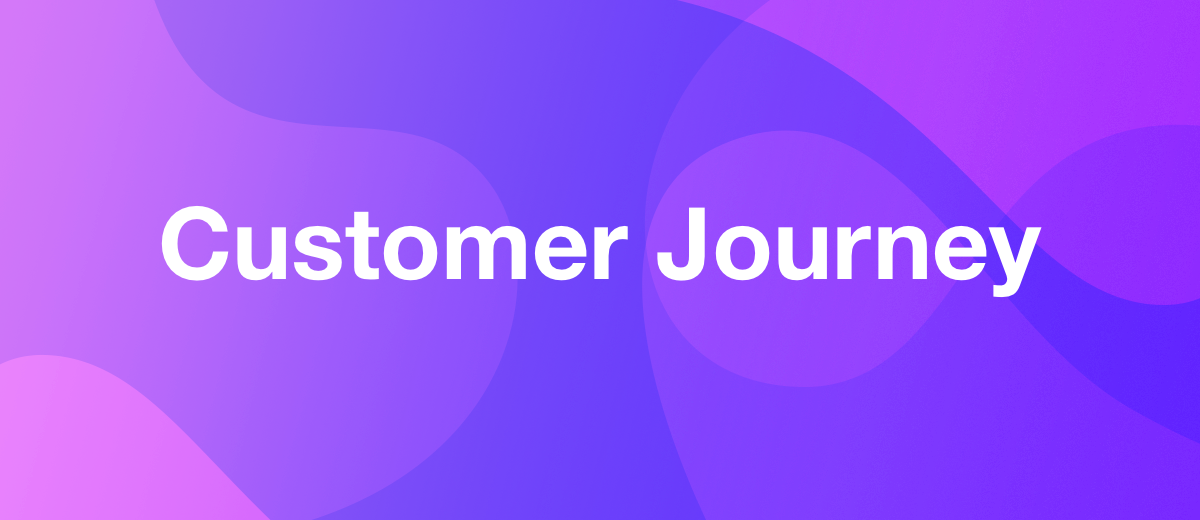What is a Customer Journey
In our next article, we will tell you about such a modern marketing technique as a customer journey. From it you will learn about what CJ is, why it is needed, how to build it, and what should be considered. We will also give some relevant examples of a customer journey and talk about other existing types of customer cards.
Content:
1. Customer journey and customer journey map - what is it?
2. What are the stages of the customer journey?
3. Why do I need a customer journey map (CJM)?
4. How to build a customer journey map?
5. Popular formats and common CJM errors
6. What other types of maps are there for mapping?
7. Conclusion
The ever-increasing competition is forcing marketers to look for ever more effective methods of attracting customers, for which they have to literally put themselves in their place. One of these techniques is to study the customer journey and draw up a plan of the intentions and actions of a potential client.
Customer journey and customer journey map - what is it?
A customer journey is a sequence of expectations, intentions and actions of a potential customer. It begins with the moment the need for a product or service arises and ends with the purchase or first use of the product.
The customer jorney is somewhat similar to a sales funnel, but it has a number of important differences. First of all, CJ is not characterized by a linear sequence of stages; instead, the buyer can skip any stage on the path to purchase or go through it several times. Also very important for the customer journey are the emotions and desires of the buyer, which act as an incentive for his intentions and actions. Equally important, in many cases, CJ does not end at the purchase stage, but continues through the post-sales collaboration with the brand. You can try GA Connector for tracking and better understanding your customer journey.
In order to better understand all stages of the customer journey and their features, marketers visualize it using the customer journey map (CJM). It is compiled on behalf of the user himself and is displayed as a graph with certain data. Among them are:
- Description of the stages of the client's actions from his acquaintance with the product to the purchase.
- Expectations, motives, emotions and intentions that arise at every step.
- The most effective channels of interaction between the client and the brand.
What are the stages of the customer journey?
It is believed that using the example of a customer journey map, marketers can track all stages of a client's readiness to purchase: from the first intention to the maximum level of brand loyalty. Briefly, they can be represented as follows:
- Awareness. The client is aware of their problem or need.
- Consideration. The client begins to look for a solution to his problem/need.
- Decision. The client finds a solution to his problem/need and starts looking for a suitable offer.
- Purchasing. The customer makes the first purchase of the product or service he has chosen and forms the first impression of the product.
- Loyalty. If the product helped to solve his problem or need, then the client becomes loyal to the brand and makes repeated purchases.
- Advocacy. At the final stage of CJM, the client reaches the maximum degree of loyalty and is ready to recommend the brand and its products to others.

Why do I need a Customer Journey Map (CJM)?
Compiling a customer journey map is a very important task for marketers, as it shows a complete picture of customer interaction with a brand and its product. The map can display all those often small, but important factors and points of contact that lead a potential buyer to make a purchase decision. As well as all the negative factors that delay or lead the client out of his way.
Thus, the customer journey map helps:
- To see the strengths and weaknesses of the marketing or sales strategy;
- Improve the sales funnel, reduce the number of cycles in it;
- Better understand and more effectively solve problems / close the pains of customers with the help of their products;
- Visualize the customer experience of interacting with the brand and product, as well as effectively manage it;
- To make customer familiarization with the product easier and more comfortable, which will reduce the number of objections in the process of its sale;
- Take action to optimize marketing campaigns and improve customer experience.
Proper use of this marketing tool helps to increase the level of customer loyalty, which leads to an increase in sales figures and replenishment of the customer base. Compiling a CJM helps streamline marketing by making it more structured, manageable, and predictable.
How to build a customer journey map?
In order to create a reliable and working customer journey map, you must first conduct a comprehensive marketing analysis. The data obtained will help to display the behavior of a typical user at all stages of his interaction with the company and its product.
In the process of developing a CJM, attention should be paid to the following stages:
- Study the target audience and draw up a portrait of a typical buyer. This is a very important and defining stage, on the basis of which the entire further path of the client will be built. If you have several products with different target audiences, then you need to create a separate map for each of them. The profile of the average buyer should indicate their expected gender, age, place of residence, profession, preferences, habits, pains/problems, behavioral factors, and other relevant information.
- Analyze the product and create a portrait of buyer-persons. The second step in the development of the CJM should be a detailed analysis of the product. This will highlight its properties and benefits that can attract buyer-persons - a collective image of a particular category of customers. Unlike the portrait of a typical buyer, there will most likely be several such personas. As a result of the analysis, you will receive information about what features of the product are important for buyer-personas, what can hook them and interest them, how to introduce these personas to your product and what can repel them in it.
- Analyze the stages of the customer journey. Further, to create a customer journey map template, it is necessary to draw up an ideal customer journey to the product: from understanding the problem/need to the first purchase and subsequent stages (repeated purchases/recommendations). Here you need to think through the step-by-step path of the jorney customer in accordance with the six stages indicated earlier, and then prescribe his intended goals for all stages. It is also recommended to indicate the approximate time frame for each stage. Choose customer service software to gather all the customer information required and personalize their journey to success.
- Define user interaction points. The next step is to analyze the information about the target audience and the customer journey again. Here it is important to highlight the most popular communication channels among potential customers and the ways they get to know the brand and its product. To do this, you need to make a list of all possible points of contact between the company and its target audience: social networks, website, contextual advertising, email / SMS mailings, outdoor advertising, stores / sales offices, etc. Define what your target audience prefers on that matter because some groups may prefer using telephone service to contact businesses, while others want to messaging platforms; therefore, create a communication strategy based on their preferences.
- Reveal emotions and barriers. Next, in the course of drawing up an example of a customer journey, you should consider what emotions he can experience at each of the stages. Understanding the emotions of users is a very important advantage that allows you to create the most accurate and efficient custom journey map. In addition, it is worth identifying potential barriers that prevent the client from moving to the next stage of their journey to the product. Such factors can be very different: high price, lack of a convenient way of communication, remote location of the store/office, etc.
- Consider ways to remove barriers. After you have analyzed your customer journey map and found all the possible problems that may arise on the customer journey, you need to think about methods for solving them. Here you need to carefully study all the weak points and understand what causes doubts, difficulties or negative emotions in customers. This way you will understand what needs to be improved: product, service, marketing, service, support, etc. Then formulate tasks to eliminate these shortcomings and delegate them to responsible employees. When you are up to a project, keeping track and having a backlog in place is important.
- Update CJM as needed. The user journey map is not a strictly fixed instruction, it can and should be reviewed and changed. It is necessary to edit or build a new CJM in many cases: when a new product, target audience, promotion channels, entering a new market, new barriers, etc. appear. Your map should instantly adapt to any change in the customer journey.
Popular formats and common CJM errors
Today, there are several key types of customer journey map templates, in particular:
- Table. The simplest and most popular CJM format, which is compiled extremely quickly and is suitable for any business area. In the table, you can flexibly structure a variety of data: for example, in the cells you can indicate the stages of the path and actions of a potential client vertically, and horizontally - his expectations, emotions and experience. Or, mark the stages of the customer journey as levels of the sales funnel horizontally (search, selection, purchase, etc.), and write down the likely goals and questions of the client, points of contact and solutions vertically.
- Mindmap. A more modern customer journey mapping format involves the creation of a circular map that covers not only the customer journey, but also other aspects of the business. This type of CJM has become widespread among technology and digital companies. The mind map includes two circles: the inner one displays the company's activities (products or services offered to it), and the outer one shows the goals/intentions/problems/pains of its target audience. The points of contact between the company and customers are displayed as icons. A mind map helps you figure out which direction your business should go in order to better fit into the user experience.
- Infographics. Another popular type of CJM is infographics: they allow you to visualize the customer journey visually, making the map more understandable and memorable. In general, this is a very flexible marketing tool, the format and appearance of which can be easily changed depending on the scope, specifics, company goals and other factors.
As is the case with any other maps for mapping, when compiling a customer journey map, mistakes can be made. Next, we will look at the most common of them:
- Lack of segmentation. A universal map of the user journey “for everyone” is unlikely to bring at least some tangible benefit. Therefore, it must be divided into segments “Product X + Audience X”, with a separate path for each combination.
- Lack of data. Before starting to develop a user journey map, attention should be paid to collecting and analyzing up-to-date data about the company, product, target audience, competitors, etc. Market research, end-to-end and web analytics services, information from CRM, etc. are often used as their sources. Without reliable data, you can miss a lot and create an inaccurate or completely erroneous customer journey.
- Surface description. Sometimes marketers make another common mistake when they prescribe the user path too briefly and generally, without delving into the details. Also, some of them confuse CJM with a sales funnel, marking only sales stages in the customer journey map. But at the same time, they forget about the significance of the preliminary and subsequent stages, which greatly reduces the effectiveness of the map.

What other types of maps are there for mapping?
The customer journey map is far from the only customer communication map used in marketing. There are also some alternative mapping methods:
- User journey map (UJM). Some marketers separate CJM and UJM into two different maps, believing that the term customer journey refers to the buyer's journey (from recognizing a problem to purchasing a product), and user journey is a separate user journey after purchasing a product. Thus, everything in it needs to describe all further stages, including the first acquaintance with the product, repeated purchases, etc.
- Customer experience map (CEM). This is a larger study, with which you can describe the life experience of a potential buyer as a whole, and not just in the context of interaction with the product. With its help, marketers try to more accurately determine the emotions, intentions, goals, problems and behaviors of the target audience. A user experience map will be useful for brand development: it helps to understand what other needs/pains of the target audience it can cover with its product.
- Service blueprint (SB). This map visualizes all the business processes taking place in the company, describing the relationships between them, the employees who perform them, and customers. The SB is created as an add-on for a specific user experience map and shows the custom jorney from the company side. The service map helps you understand which departments and employees are responsible for touch points with the client at different stages of his journey. Using its data, you can optimize the interaction by supplementing or changing existing processes.
Conclusion
Customer journey is a visualization of the way a client interacts with a brand and its product, compiled on behalf of the client. It displays the goals, needs, intentions and actions of the user, as well as the emotions he experiences while doing so. CJM is presented as a sequence of stages that a client goes through from realizing his problem to finding its solution in the form of a product, buying it and building loyalty.
The development of a customer journey map helps marketers to better understand their target audience and its motivation, to more accurately determine the channels of receipt of customers and their points of contact with the brand / product. Customer journey mapping can be visualized as a table, infographic or mind map. There are also other types of such maps: a user journey map, a customer experience map, and a service map.
Apix-Drive is a simple and efficient system connector that will help you automate routine tasks and optimize business processes. You can save time and money, direct these resources to more important purposes. Test ApiX-Drive and make sure that this tool will relieve your employees and after 5 minutes of settings your business will start working faster.

